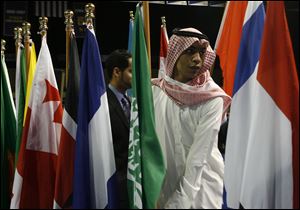
Foreign students bring wealth
Study says cities can better capitalize on opportunities
8/29/2014
In the Toledo area, there were 3,689 foreign students on F-1 visas, according to Brookings. That puts Toledo 66th among the 118 metro areas.
Toledo and other U.S. cities can do a better job of capitalizing on foreign students’ connections to their home markets, according to a report released today by the Brookings Institution.
The Washington-based think tank studied the economic impact of foreign students at U.S. colleges and universities from 2008-12. Brookings concentrated on those with F-1 visas, which is the most common visa issued to full-time foreign students.
“As we kick off a new school year, it’s important to understand how students from fast-growing foreign nations can help build global connections and shore up our local economies and businesses,” said Neil Ruiz, associate fellow for the Brookings Metropolitan Policy Program and author of the report.
From 2008-12, foreign students contributed $21.8 billion in tuition and $12.8 billion in living costs in the 118 metro areas that were home to at least 1,500 foreign students.
In the Toledo area, there were 3,689 foreign students on F-1 visas, according to Brookings. That puts Toledo 66th among the 118 metro areas.
Toledo ranked 73rd in percentage of foreign students, with 17.9 per 1,000 total students.
Those students spent about $66 million on tuition and $28.5 million on living expenses during that five-year period, according to the study.
“Foreign students are a significant source of earnings for U.S. metro economies in several ways,” said Brookings’ Mr. Ruiz. “First, they open up markets in their home cities which facilitates trade, foreign direct investment, and knowledge transfer.
“In addition, they infuse revenue into local communities, and they help fill demand for jobs requiring specific skills in local labor markets. Our business and community leaders need to develop better strategies that retain their talents after they graduate.”
Students can extend their visas through the optional practical training program often called OPT. It allows students in science, technology, engineering, and mathematics fields, often called STEM to stay in the United States for an extra 29 months. Other graduates can stay 12 months.
Nationally, about 45 percent of foreign student graduates extend their visas to work in the same metro area where they studied.
But only 22 percent of foreign students stayed in the Toledo area, ranking 85th of the 118 metro areas.
According to Brookings, 46.1 percent of the foreign students in metro Toledo were in STEM fields. But the most common areas of study were business, management, and marketing.
In metro Toledo, the University of Toledo had the most foreign students, followed by Bowling Green State University, Lourdes University, and Owens Community College.
About 48 percent were pursuing a bachelor’s degree, 36 percent a master’s degree, and 16 percent a doctorate.
According to Brookings, 1,380 students came from China, 535 from India, 458 from Saudi Arabia, 165 from South Korea, and 110 from Canada.
Contact Chip Towns at: ctowns@theblade.com or 419-724-6194.